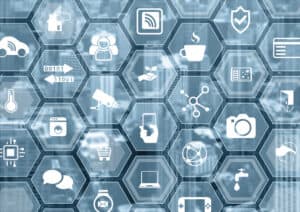
The merging of AI and IoT enables autonomous connected devices that have the ability to independently decide and execute the best course of action.
Artificial intelligence is converging with the Internet of Things, and the result is something called “AIoT.” It means IoT networks and associated endpoints may be able to operate, self-heal, and deliver data and insights in real-time with little or no human intervention.
“The merging of artificial intelligence (AI) and the Internet of Things (IoT) transforms how we interact with the world around us,” says Antonio Grasso, who discusses the rise of AIoT in his latest work, Toward a Post-Digital Society. “AIoT is the confluence of IoT and AI to build intelligent network and systems that can better inform thinking.”
Associated real-time applications are emerging as these two far-reaching technologies align. Many companies are learning to use AIoT “to improve security in real-time data analysis, as it helps to detect trends and spikes in demand, or suspicious events, which helps to keep users safe during a purchase process,” recent post by Telefónica states.
AIoT brings autonomy
In this sense, AIoT “can be defined as a new technology in charge of providing physical elements with autonomy so that they can analyze the situation and make decisions based on automatic learning,” the Telefónica authors state.
“Another significant example is the use of AIoT in autonomous vehicles,” the co-authors state. “It is installed in the on-board computer, cameras and other connected elements, so that they can be able to make autonomous decisions in real time, taking into account road conditions, road safety, and driving mode.”
See also: Addressing the Challenges of Real-Time Data Sharing in IoT
Grasso outlines the evolution of AIoT from its early IoT roots:
- Siloed IoT: The system core controls devices. Sensoring and monitoring is the core feature. “A network of sensors that ingest data on the environment and help monitor varios environment-related attributes.”
- Connected IoT: The devices are interconnected and interact with each other. Management and control is the core feature. “Unifications, cleaning, classification, and storage of the data ingested through various connected sensors.”
- Augmented IoT: An ecosystem of connected devices augmented with analytics to enhance their value. Augmentation is the core feature. “The analysis of data processed from sensors to derive insights to optimally control the connected environment.”
- AIoT: An intelligence-driven ecosystem of connected devices with autonomous operations. Autonomy is the core feature. “The ability to independently decide and execute the best course of action.”
AIoT provides “the next evolutionary step in the technology sector that gives even more value to data,” the Telefónica authors agree. Taken alone, the IoT “is based on connectivity that allows physical elements, devices, to transfer data over a wireless network and communicate with other devices.”
Such technology “is increasingly present in industrial, agricultural and health sectors, and even in buildings and a good number of elements that are part of the so-called smart cities,” they add. “It also offers a wealth of options and opportunities to improve people’s lives and work environments.”
The Al portion enables networks to “detect errors and warn of them in the future,” as well as support “corporate strategies in recruitment processes or in the field of supply chains.”
Examples of additional AIoT applications range from industrial environments to leisure and tourism, from agriculture and livestock farming to transport and logistics, from banking and insurance, the Telefónica authors explain.
AIoT is also present “in today’s smartphones, as they use intelligent applications that are able to learn and respond automatically through human interaction.,” they continue. “One example is voice assistants such as Siri, Alexa or Cortana, through which the user can perform searches, make calls, compose messages or open other applications.”
AIoT, they add, “is also used in the recommendation systems installed in applications, social networks, emails and streaming platforms, among others. These tools are designed to generate and provide suggestions and content to the user in a personalized way. They use AI algorithms and machine learning techniques to create an advanced neural network between products and users.”
In addition, “users do not have to spend time checking devices, as AIoT-based systems are autonomous, which saves resources and time,” the co-authors point out. “And thanks to the deployment of the 5G network, the number of devices connected to each other can increase, optimizing processes and improving scalability.”




























